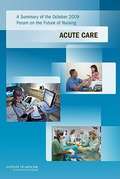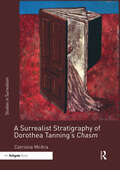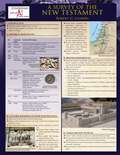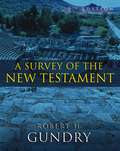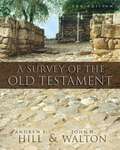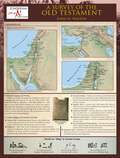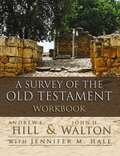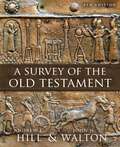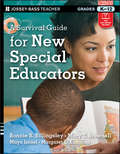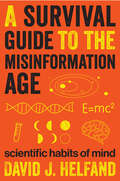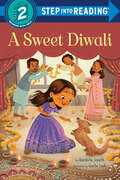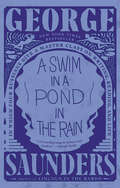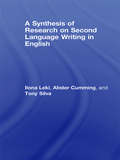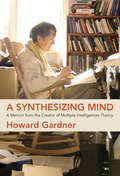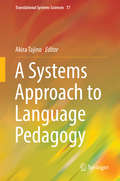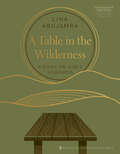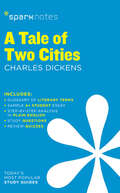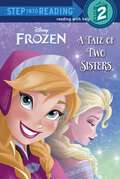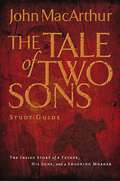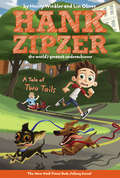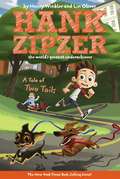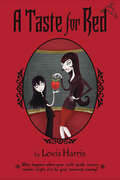- Table View
- List View
A Summary of the October 2009 Forum on the Future of Nursing: Acute Care
by Institute of Medicine of the National AcademiesThe Robert Wood Johnson Foundation Initiative on the Future of Nursing, at the IOM, seeks to transform nursing as part of larger efforts to reform the health care system. The first of the Initiative's three forums was held on October 19, 2009, and focused on safety, technology, and interdisciplinary collaboration in acute care.
A Surrealist Stratigraphy of Dorothea Tanning’s Chasm (Studies in Surrealism)
by Catriona McAraIn A Surrealist Stratigraphy of Dorothea Tanning’s Chasm, Catriona McAra offers the first critical study of the literary work of the celebrated American painter and sculptor Dorothea Tanning (1910–2012). McAra fills a major gap in the scholarship, repositioning Tanning’s writing at the centre of her entire creative oeuvre and focusing on a little-known short story "Abyss," a gothic-flavoured, desert adventure which Tanning worked on intermittently throughout her creative life, finally publishing it in 2004 as Chasm: A Weekend.McAra performs a major reassessment of the visual and literary principles upon which the surrealist movement was initially founded. Combining a groundbreaking methodological approach with reference to cultural theory and feminist aesthetics as well as Tanning’s unpublished journals and notes, McAra reveals Tanning as a key player in contemporary art practice as well as in the historical surrealist milieu.
A Survey of the New Testament Laminated Sheet: 4th Edition (Zondervan Get an A! Study Guides)
by Robert H. GundryStudents of the New Testament may not know everything they need to know, but they do know there's a lot they need to know! Whether studying for exams or delving into New Testament Scripture, students need critical information at their fingertips. Instead, it's usually scattered throughout textbooks, self-made crib sheets, and sticky-notes on their computer monitor. Now there's a better way! The Zondervan Get an A! Study Guides to Survey of the New Testament is a handy, at-a-glance study aid ideal for last minute review, a quick overview of the textbook, or as an aid in New Testament study. The study guide is tied to A Survey of the New Testament by Robert Gundry.
A Survey of the New Testament: 5th Edition (Zondervan Get An A! Study Guides)
by Robert H. GundryThis revised edition of Gundry’s Survey of the New Testament goes beyond providing background information and technical introductory material and leads students to read the New Testament itself. Whenever possible general questions of introduction and background are tied to assigned readings covering the entire New Testament. In addition, comments on these readings help students with interpretation and follow the flow of thought from one passage to another. Features include: - New design with four-color format and more photos and improved maps - Links to relevant websites - Chapters that begin with list of study goals and end with summary, overview and of people, places, terms to remember, and review questions - Outlines, section headings, subheadings, and bolded items to make it easy to follow structure of discussion - Phonetic pronunciations for unfamiliar names and terms - Breakouts with illustrative quotes from ancient, nonbiblical literature - Discussion questions on the contemporary relevance of the New Testament - Updated bibliographies - Conservative evangelical theological perspective that also notes other positions and literature
A Survey of the Old Testament
by John H. Walton Andrew E. HillThis innovative textbook at long last provides an Old Testament survey for undergraduate students that goes beyond basic content. The book attempts to balance the literary, historical, and theological issues pertaining to each individual book and to the Old Testament as a whole. The main portion of the survey treats each book of the Old Testament in the order of the English canon. This information does not simply rehash the biblical material, but assumes that the Scriptures are being read alongside the survey. The book focuses its primary attention on the purpose and message of each book and attempts to show how the literary structure of each one has been used to accomplish the author's purpose. The survey also introduces readers to the issues of hermeneutics (general and special), history (Israelite and Near Eastern), archaeology, canon, geography, Old Testament theology (biblical and systematic), and critical methodologies. All these issues are dealt with in separate chapters at a basic introductory level that never allows the reader to lose sight, as it were, of the forest while wandering through the trees. In addressing critical issues of date and authorship, the survey avoids a polemical stance. Hill and Watson seek to depend on the evidence of the text rather than on presuppositions to substantiate their views. Their commitment to the authority of the biblical text results in a book that, while notably evangelical, is not always traditional. The authors approach the survey mindful of two complicating factors in Old Testament study. First, God's revelation did not come by way of the English language or through Western culture, and therefore we today have to work carefully to receive the message clearly. Second, even when we are listening, we have a tendency to be selective about what we hear or to try to make the message conform to our ideas. The solution is to allow the Bible to speak for itself. The informed reader will find much innovation here and a keen awareness of current scholarship relating to the Old Testament. Above all, this textbook will bring a new vigor and excitement to the Old Testament as readers learn to discover its story for themselves and see how to understand it as a substantial part of God's self-revelation to humankind. This survey is well illustrated with maps, charts, and photographs. Additional features are the questions for study and the annotated reading list at the end of each chapter.
A Survey of the Old Testament Laminated Sheet (Zondervan Get an A! Study Guides)
by John H. WaltonStudents of the Old Testament may not know everything they need to know, but they do know there's a lot they need to know! Whether studying for exams or delving into Old Testament Scripture, students need critical information at their fingertips. Instead, it's usually scattered throughout textbooks, self-made crib sheets, and sticky-notes on their computer monitor. Now there's a better way! The Zondervan Get an A! Study Guides to A Survey of the Old Testament is a handy, at-a-glance study aid ideal for last minute review, a quick overview of the textbook, or as an aid in Old Testament study. The study guide is tied to A Survey of the Old Testament by Andrew Hill and John Walton.
A Survey of the Old Testament Workbook
by John H. Walton Andrew E. Hill Jennifer M. HaleThis workbook accompanies A Survey of the Old Testament by Andrew E. Hill and John H. Walton. It follows the textbook's structure and offers readings, activities, and exercises designed to support the students' learning experience as they explore the literary, historical, and theological issues behind each book of the Old Testament.A Survey of the Old Testament Workbook offers students an additional contact point with the content and concepts from the main textbook and will help them better understand the Old Testament, its background, purpose, message, structure, and major themes. This workbook is an indispensable study resource for students and independent learners alike who want to deepen their understanding of the Old Testament and the God it reveals.
A Survey of the Old Testament Workbook: Revised and Updated
by John H. Walton Andrew E. HillThis workbook accompanies A Survey of the Old Testament, Fourth Edition by Andrew E. Hill and John H. Walton. It follows the textbook's structure and offers readings, activities, and exercises designed to support the students' learning experience as they explore the literary, historical, and theological issues behind each book of the Old Testament.A Survey of the Old Testament Workbook offers students an additional contact point with the content and concepts from the main textbook and will help them better understand the Old Testament, its background, purpose, message, structure, and major themes. This workbook is an indispensable study resource for students and independent learners alike who want to deepen their understanding of the Old Testament and the God it reveals.
A Survey of the Old Testament: Fourth Edition
by John H. Walton Andrew E. HillAn indispensable guide for exploring the literary, historical, and theological issues behind the Old Testament.The purpose of studying the Old Testament is to understand God and his redemptive work more fully. However, this goal is complicated by the fact that it was transmitted through a very different language and culture from our own. A Survey of the Old Testament addresses background information, purpose, message, structure, and major themes of the Old Testament to help readers understand its message and relevance.Chapters introducing each major section of the Old Testament are included, as are chapters dealing with issues of interpretation, hermeneutics, theology, geography, archaeology, history, formation of the Old Testament canon, and the Old Testament's relationship to the New Testament. The fourth edition features a renewed focus on purpose, theology, and message while also providing a more succinct textbook less intimidating to students.Features included for each book of the Old Testament:Writing of the BookBackgroundOutline of the BookPurpose and MessageStructure and OrganizationMajor ThemesQuestions for Further Study and DiscussionFurther ReadingComplete with updated full-color maps, photos, timelines, and charts, the latest edition of this widely acclaimed textbook is a useful and readable tool for students and other readers who wish to better understand the Old Testament and God's redemptive work.
A Survival Guide for New Special Educators
by Mary T. Brownell Margaret L. Kamman Bonnie S. Billingsley Maya IsraelWhat every special education teacher needs to know to survive and thriveA Survival Guide for New Special Educators provides relevant, practical information for new special education teachers across a broad range of topic areas. Drawing on the latest research on special educator effectiveness and retention, this comprehensive, go-to resource addresses the most pressing needs of novice instructors, resource teachers, and inclusion specialists.Offers research-based, classroom-tested strategies for working with a variety of special needs studentsCovers everything from preparing for the new school year to behavior management, customizing curriculum, creating effective IEPs, and moreBillingsley and Brownell are noted experts in special educator training and supportThis highly practical book is filled with checklists, forms, and tools that special educators can use every day to help ensure that all special needs students get the rich, rewarding education they deserve.
A Survival Guide to the Misinformation Age: Scientific Habits of Mind
by David HelfandWe live in the Information Age, with billions of bytes of data just two swipes away. Yet how much of this is mis- or even disinformation? A lot of it is, and your search engine can't tell the difference. As a result, an avalanche of misinformation threatens to overwhelm the discourse we so desperately need to address complex social problems such as climate change, the food and water crises, biodiversity collapse, and emerging threats to public health. This book provides an inoculation against the misinformation epidemic by cultivating scientific habits of mind. Anyone can do it—indeed, everyone must do it if our species is to survive on this crowded and finite planet.This survival guide supplies an essential set of apps for the prefrontal cortex while making science both accessible and entertaining. It will dissolve your fear of numbers, demystify graphs, and elucidate the key concepts of probability, all while celebrating the precise use of language and logic. David Helfand, one of our nation's leading astronomers and science educators, has taught scientific habits of mind to generations in the classroom, where he continues to wage a provocative battle against sloppy thinking and the encroachment of misinformation.
A Survival Guide to the Misinformation Age: Scientific Habits of Mind
by David J. HelfandLearning how to tell news from fake news from fake fake news: An &“important and timely&” book on protecting ourselves, and society, from the infodemic (Library Journal). We have billions of bytes of data at our fingertips. But how much of it is misinformation—or even disinformation? A lot of it is, and your search engine can&’t tell the difference. As a result, an avalanche of misinformation threatens to overwhelm the discourse we so desperately need to address complex social problems such as climate change, the food and water crises, biodiversity collapse, and emerging threats to public health. This book provides an inoculation against the misinformation epidemic by cultivating scientific habits of mind. Anyone can do it—indeed, everyone must do it if our species is to survive on this crowded and finite planet. This survival guide supplies an essential set of apps for the prefrontal cortex while making science both accessible and entertaining. It will dissolve your fear of numbers, demystify graphs, and elucidate the key concepts of probability, all while celebrating the precise use of language and logic. David Helfand, one of our nation&’s leading astronomers and science educators, has taught scientific habits of mind to generations in the classroom, where he continues to wage a provocative battle against sloppy thinking and the encroachment of misinformation. &“Provides a vital antidote to the ills of misinformation by teaching systematic and rigorous scientific reasoning.&” —The Times Literary Supplement
A Sweet Diwali (Step into Reading)
by Harshita JerathJoin a young girl and her dog in this Step 2 reader as they joyfully prepare to celebrate Diwali, the Hindu festival of lights! Perfect for readers ages 4-6.Raina is excited to celebrate Diwali, a Hindu holiday that symbolizes the victory of light over darkness. Along with her family and her best friend, Lion (a little dog with a big sweet tooth!), Raina helps prepare for the celebration. She decorates the house with clay lamps called diyas, makes beautiful rangoli designs with sand, watches colorful fireworks, and shares sweet treats with Lion. It&’s a Diwali to remember!Step 2 Readers use basic vocabulary and short sentences to tell simple stories, for children who recognize familiar words and can sound out new words with help. Rhyme and rhythmic text paired with picture clues help children decode the story.
A Swim in a Pond in the Rain: In Which Four Russians Give a Master Class on Writing, Reading, and Life
by George SaundersFrom the New York Times bestselling, Booker Prize–winning author of Lincoln in the Bardo and Tenth of December comes a literary master class on what makes great stories work and what they can tell us about ourselves—and our world today.For the last twenty years, George Saunders has been teaching a class on the Russian short story to his MFA students at Syracuse University. In A Swim in a Pond in the Rain, he shares a version of that class with us, offering some of what he and his students have discovered together over the years. Paired with iconic short stories by Chekhov, Turgenev, Tolstoy, and Gogol, the seven essays in this book are intended for anyone interested in how fiction works and why it&’s more relevant than ever in these turbulent times.In his introduction, Saunders writes, &“We&’re going to enter seven fastidiously constructed scale models of the world, made for a specific purpose that our time maybe doesn&’t fully endorse but that these writers accepted implicitly as the aim of art—namely, to ask the big questions, questions like, How are we supposed to be living down here? What were we put here to accomplish? What should we value? What is truth, anyway, and how might we recognize it?&” He approaches the stories technically yet accessibly, and through them explains how narrative functions; why we stay immersed in a story and why we resist it; and the bedrock virtues a writer must foster. The process of writing, Saunders reminds us, is a technical craft, but also a way of training oneself to see the world with new openness and curiosity.A Swim in a Pond in the Rain is a deep exploration not just of how great writing works but of how the mind itself works while reading, and of how the reading and writing of stories make genuine connection possible.
A Synthesis of Research on Second Language Writing in English
by Tony Silva Alister Cumming Ilona LekiSynthesizing twenty-five years of the most significant and influential findings of published research on second language writing in English, this volume promotes understanding and provides access to research developments in the field. Overall, it distinguishes the major contexts of English L2 learning in North America, synthesizes the research themes, issues, and findings that span these contexts, and interprets the methodological progression and substantive findings of this body of knowledge. Of particular interest is the extensive bibliography, which makes this volume an essential reference tool for libraries and serious writing professionals, both researchers and practitioners, both L1 and L2. This book is designed to allow researchers to become familiar with the most important research on this topic, to promote understanding of pedagogical needs of L2 writing students, and to introduce graduate students to L2 writing research findings.
A Synthesizing Mind: A Memoir from the Creator of Multiple Intelligences Theory
by Howard GardnerThe influential author and eminent authority on the human mind reflects on his groundbreaking work and the many forms of intelligence--including his own.Howard Gardner's Frames of Mind was that rare publishing phenomenon--a mind-changer. Widely read by the general public as well as by educators, this influential book laid out Gardner's theory of multiple intelligences. It debunked the primacy of the IQ test and inspired new approaches to education; entire curricula, schools, museums, and parents' guides were dedicated to the nurturing of the several intelligences. In his new book, A Synthesizing Mind, Gardner reflects on his intellectual development and his groundbreaking work, tracing his evolution from bookish child to eager college student to disengaged graduate student to Harvard professor.
A Systems Approach to Language Pedagogy (Translational Systems Sciences #17)
by Akira TajinoThis volume represents the first attempt in the field of language pedagogy to apply a systems approach to issues in English language education. In the literature of language education, or more specifically, second or foreign language learning and teaching, each topic or issue has often been dealt with independently, and been treated as an isolated item. Taking grammar instruction as an example, grammatical items are often taught in a sequential, step-by-step manner; there has been no “road map” in which the interrelations between the various items are demonstrated. This may be one factor that makes it more difficult for students to learn the language organically. The topics covered in this volume, including language acquisition, pedagogical grammar, and teacher collaboration, are viewed from a holistic perspective. In other words, language pedagogy is approached as a dynamic system of interrelations. In this way, “emergent properties” are expected to manifest. This book is recommended for anyone involved in language pedagogy, including researchers, teachers, and teacher trainers, as well as learners.
A Table in the Wilderness: A Study on God's Goodness (Mapping the Footsteps of God Series)
by Lina AbuJamraThis unique six-week Bible study with companion videos is for individuals and groups hungry to be refreshed as they draw closer to the God who delights in providing everything they need. Stories of God&’s tables of blessing are woven throughout Scripture. In addition to an introduction about why God chooses to feed us in order to teach us about His goodness, A Table in the Wilderness offers in-depth Bible study on five tables that God offers as physical and spiritual reminders of His love, mercy, and overflowing kindness: Salvation (Passover)—when you need to be rescued Unexpected belonging (King David&’s table)—when you deserve to be punished Overflowing satisfaction (the wedding at Cana)—when you feel empty Remembrance (the Lord&’s Supper)—when you&’re likely to forget Eternal celebration (the marriage supper of the Lamb)—when life is hard This substantive, applicable, and richly spiritual study includes a QR code for quick access to streaming videos, spiritual exercises for contemplation and prayer, a self-reflection tool, and a leader&’s guide for small group study. Even in the most unexpected places—our weaknesses, our sins, our doubts—God loves to invite us into His presence. You are invited! Come to the table.
A Tale of Two Cities SparkNotes Literature Guide (SparkNotes Literature Guide Series)
by SparkNotesA Tale of Two Cities SparkNotes Literature Guide by Charles Dickens Making the reading experience fun! When a paper is due, and dreaded exams loom, here's the lit-crit help students need to succeed! SparkNotes Literature Guides make studying smarter, better, and faster. They provide chapter-by-chapter analysis; explanations of key themes, motifs, and symbols; a review quiz; and essay topics. Lively and accessible, SparkNotes is perfect for late-night studying and paper writing. Includes:An A+ Essay—an actual literary essay written about the Spark-ed book—to show students how a paper should be written.16 pages devoted to writing a literary essay including: a glossary of literary termsStep-by-step tutoring on how to write a literary essayA feature on how not to plagiarize
A Tale of Two Sisters (Step into Reading)
by Melissa LagonegroFearless optimist Anna sets off on an epic journey—teaming up with rugged mountain man Kristoff and his loyal reindeer Sven—to find her sister Elsa, whose icy powers have trapped the kingdom of Arendelle in eternal winter. Encountering Everest-like conditions, mystical trolls and a hilarious snowman named Olaf, Anna and Kristoff battle the elements in a race to save the kingdom. This Step 2 Step into Reading leveled reader brings all the magic and adventure of Disney Frozen to children ages 4-6 who are just learning to read on their own.
A Tale of Two Sons Bible Study Guide
by John F. MacArthurIn The Tale of Two Sons Workbook, one of America's greatest Bible teachers takes readers deeper into Luke 15 than they've ever been before, revealing insights into the culture of Jesus' day and a surprise secret ending.The Parable of the Prodigal Son (Luke 15:11-32) has been preached in every pulpit and is known by many who read and cherish the Bible. It's so special because it presents in clear and inspiring terms our struggle with sin, the need of our hearts to be accepted and pursued, and the Father's inexhaustible mercy and love. But most Christians would say that they've heard every sermon possible from this gem of scripture. That it has lost its luster. In The Tale of Two Sons, one of America's most beloved pastors restores the brilliance of this passage for the layperson, giving engrossing historical background and a surprise ending readers may have never known.
A Tale of Two Tails (Hank Zipzer, The World's Greatest Underachiever #15)
by Henry Winkler Oliver Lin<p>Hank enters his dog Cheerio in a show, hoping to win the big prize. Unfortunately for Hank, Nick McKelty and his gassy little Chihuahua have the same thing in mind. <p>Will Hank and Cheerio be able to take home the ribbon for Best in Show? <p> <p><b>Lexile Level: 780L</b></p>
A Tale of Two Tails (Hank Zipzer, the World's Greatest Underachiever #15)
by Henry Winkler Lin OliverHank enters his dog Cheerio in a show, hoping to win the big prize. Unfortunately for Hank, Nick McKelty and his gassy little Chihuahua have the same thing in mind. Will Hank and Cheerio be able to take home the ribbon for Best in Show?
A Taste for Red
by Lewis HarrisA sixth-grade Goth girl who thinks she’s a vampire encounters her greatest nemesis when she enrolls at Sunny Hill Middle School in this hilarious and entirely original take on the vampire genre for middle graders. Svetlana Grimm has recently discovered she’s a vampire. The clues are all there: she can eat only red foods, has to sleep under the bed because of her heightened sensitivity to light and noise, and can read others’ thoughts. But this new discovery is making her transition from home-schooling to attending sixth grade at Sunny Hill Middle School that much more difficult. After all, what can she possibly have in common with those jellybean-eaters in her class? She prefers to watch them from afar in her hidden lair atop the Oak of Doom in her backyard. But things get more interesting when Svetlana’s cruel yet beautiful science teacher, Ms. Larch, reads her thoughts. Svetlana is excited to have found another of her kind—until her new neighbor, The Bone Lady, fills her in on Ms. Larch's true identity and her own. What happens when your sixth-grade science teacher might also be your immortal enemy?
A Teachable Spirit: The Virtue of Learning from Strangers, Enemies, and Absolutely Anyone
by A. J. SwobodaBeing a know-it-all isn't a fruit of the Spirit. But the ancient call of Jesus beckons us to "love the Lord your God with all your heart, mind, soul, and strength" (Matt. 22:37). How do we love God with our mind? In A Teachable Spirit, A.J. Swoboda helps followers of Jesus develop the discipline of teachability.In a world marked by distraction, mind-numbing entertainment, endless content, polarization, and a decreasing desire to humbly learn from those we dislike, the way we engage sources of information like news media, science, and social media content could not be more important. Thankfully, the Christian faith provides sharp tools and rich traditions for learning how to be the best learners. By drawing on his experiences as a professor, theologian, and lay pastor, Swoboda explores the potency of seeing learning as a part of one's spiritual formation to Jesus.With the right posture, Christians can learn from even the most unexpected places.
